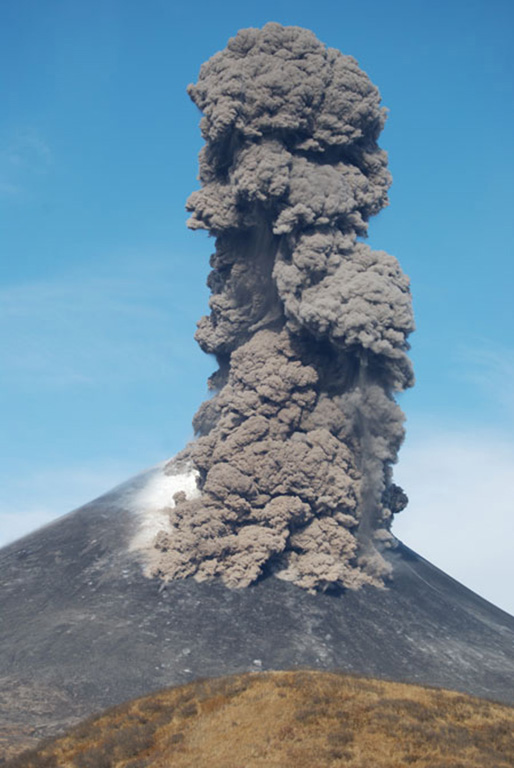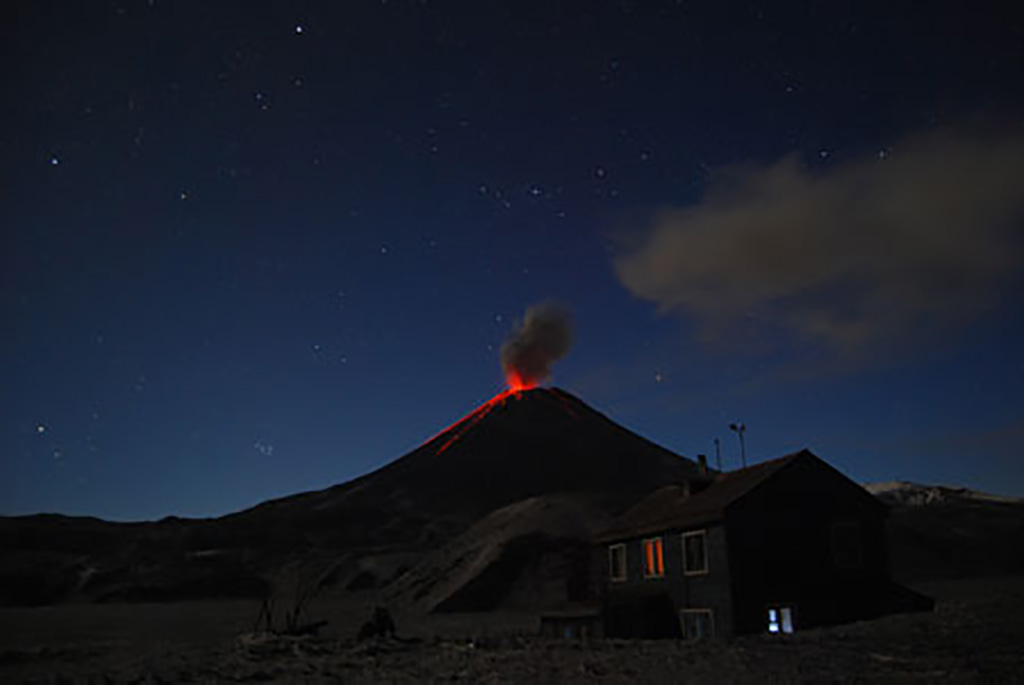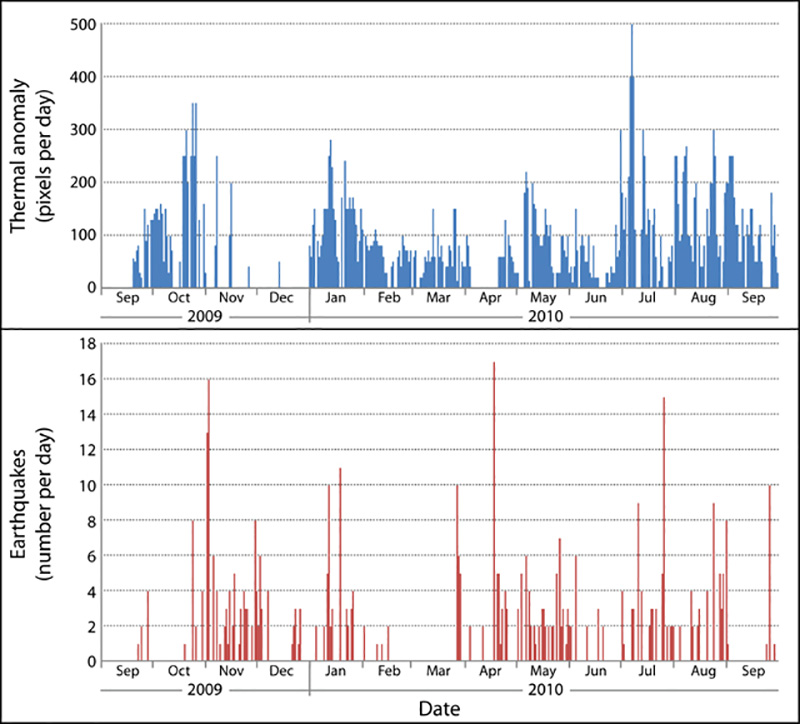Report on Karymsky (Russia) — May 2012
Bulletin of the Global Volcanism Network, vol. 37, no. 5 (May 2012)
Managing Editor: Richard Wunderman.
Karymsky (Russia) Many ash plumes to 4 km during September 2009-September 2010
Please cite this report as:
Global Volcanism Program, 2012. Report on Karymsky (Russia) (Wunderman, R., ed.). Bulletin of the Global Volcanism Network, 37:5. Smithsonian Institution. https://doi.org/10.5479/si.GVP.BGVN201205-300130
Karymsky
Russia
54.049°N, 159.443°E; summit elev. 1513 m
All times are local (unless otherwise noted)
This report on Karymsky covers September 2009 to September 2010, an interval with consistent thermal anomalies, seismic activity, and ash plumes. This report was written primarily by Jason Kaiser as part of a graduate student writing assignment in a volcanology class at Oregon State University under the guidance of professor Shan de Silva.
Activity during September 2009-September 2010 was similar to reported activity during January to September 2009 (BGVN 34:08), characterized by nearly consistent thermal anomalies (when cloud cover allowed satellite observations) and above-background seismic activity (figure 23). Ash plume altitudes averaged between 3.5 and 4 km, occurring at least once a week for large portions of this time period. These plumes typically drifted between 100 and 200 km E over the N Pacific Ocean. Ash plume altitudes reported by Kamchatka Volcanic Eruptions Response Team (KVERT) were mostly based on seismic data interpretation, rather than direct observation. Information on thermal anomalies, seismic activity, and ash plume dispersal was reported by KVERT and Tokyo Volcanic Ash Advisory Center (VAAC); first-hand observations by scientists in the area were rare. Plume altitudes and maximum dispersals during the reporting period are shown in figure 24.
After being lowered to Green in August 2009, the Aviation Color Code was again raised to Yellow on 22 September 2009, then to Orange on 23 September, both times because of increased seismicity and possible ash explosions. Scientists flying near Karymsky in a helicopter on 22 September observed ash plumes that rose to altitudes of 1.7 km and drifted E.
The Aviation Color Code remained at Orange for the rest of 2009. Thermal anomalies and above-background seismicity were common, occurring consistently each week during October-November 2009. Few direct observations were made, but scientists did note fumarolic activity on 1 October and a small ash plume reaching 3.5 km altitude and drifting SSE on 7 October. On 12 October, volcanologists doing fieldwork in the area observed and photographed an ash plume that later rose to an altitude of 3.5 km (figure 25).
 |
Figure 25. KVERT photo of an ash plume emitted by Karymsky on 12 October 2009. The plume later reached an altitude of 3.5 km. Courtesy of A. Manevich (KVERT). |
KVERT reported that ash deposits observed in satellite imagery extended 45 km SE on 6 December. No seismic or thermal data were available for 8 December 2009, yet a new lava flow on the S flank was observed on that day. Based on information from Yelizovo Airport, the Tokyo VAAC reported that on 25 December an ash plume rose to an altitude of 6.7 km. That same day, KVERT noted three linear ash deposits in satellite imagery that extended nearly 10 km SE from the vent. Smaller gas-and-steam bursts were observed by scientists in the area three days later.
Thermal anomalies were observed in satellite imagery nearly every day during January-March 2010. Above background seismicity was also common during this period. Ash explosions were assumed to be consistent with the seismic activity during this time frame, and were weak during February. The Aviation Color Code remained at Orange for much of this period, but was lowered to Yellow at the end of February.
KVERT reported that seismicity increased on 25 March 2010. On 27 March an intense thermal anomaly over the volcano was apparent in satellite imagery and ash plumes were observed in the area of the volcano during 28-29 March, drifting 250 km SSE (the longest reaching ash plume during this reporting interval, table 6). The Aviation Color Code was again raised to Orange on 29 March.
Table 6. Reported characteristics of eruptive plumes at Karymsky during September 2009-September 2010. Included are plume-top altitude (km), drift direction, and drift distance (when available). Data are courtesy of KVERT or Tokyo VAAC; '--' indicates data not reported.
| Date | Plume altitude (km) | Drift distance and direction | Source |
| 22 Sep 2009 | 2 | -- | KVERT |
| 23 Sep 2009 | 4.5 | E | KVERT |
| 07 Oct 2009 | 3.5 | SSE | KVERT |
| 09 Oct 2009 | 3 | -- | VAAC |
| 12 Oct 2009 | 3.5 | -- | KVERT |
| 20 Oct 2009 | 3.3 | -- | VAAC |
| 23 Oct 2009 | 3.9 | 120 km E | KVERT |
| 24 Oct 2009 | 3.4 | -- | VAAC |
| 25 Oct 2009 | 3.7 | -- | VAAC |
| 31 Oct 2009 | 3.7 | 180 km E | KVERT |
| 05 Nov 2009 | 3.7 | 180 km E | KVERT |
| 08 Nov 2009 | 3 | -- | VAAC |
| 10 Nov 2009 | 3.4 | 190 km E | VAAC |
| 14 Nov 2009 | 3.7 | E | VAAC |
| 17 Nov 2009 | 3 | 130 km E | KVERT |
| 23 Nov 2009 | 4 | 120 km E | VAAC |
| 25 Nov 2009 | 3.8 | 120 km E | KVERT |
| 25 Dec 2009 | 6.7 | SE | VAAC |
| 12 Jan 2010 | 3 | 113 km SE | KVERT |
| 15 Jan 2010 | 3 | -- | KVERT |
| 12 Mar 2010 | 5.8 | -- | VAAC |
| 26 Mar 2010 | 4.1 | -- | KVERT |
| 29 Mar 2010 | 4.1 | 250 km E | KVERT |
| 17 Apr 2010 | 2 | 130 km SE | KVERT |
| 20 Apr 2010 | 3 | -- | KVERT |
| 28 Apr 2010 | 3 | -- | KVERT |
| 07 May 2010 | 2 | -- | KVERT |
| 13 May 2010 | 4.6 | -- | KVERT |
| 17 May 2010 | 2.5 | 18 km NE | KVERT |
| 25 May 2010 | 4.3 | SW, NW | KVERT |
| 28 May 2010 | 3 | 63 km S, W | KVERT |
| 01 Jun 2010 | 4 | 30 km S | KVERT |
| 06 Jun 2010 | 2.5 | -- | KVERT |
| 11 Jun 2010 | 6.1 | 195 km E | VAAC |
| 12 Jun 2010 | 5.2 | -- | KVERT |
| 16 Jun 2010 | 3.9 | 22 km E | KVERT |
| 29 Jun 2010 | 7 | -- | VAAC |
| 07 Jul 2010 | 2 | 20 km S | KVERT |
| 13 Jul 2010 | 2.7 | W | VAAC |
| 14 Jul 2010 | 3.3 | -- | KVERT |
| 19 Jul 2010 | 1.5 | SW | KVERT |
| 23 Jul 2010 | 3 | 85 km SE | KVERT |
| 28 Jul 2010 | 2 | 15 km SE | KVERT |
| 30 Jul 2010 | 2 | -- | KVERT |
| 13 Aug 2010 | 2.5 | -- | KVERT |
| 16 Aug 2010 | 3 | 100 km E | VAAC |
| 20 Aug 2010 | 3.8 | -- | KVERT |
| 27 Aug 2010 | 3.8 | 23 km | KVERT |
| 03 Sep 2010 | 3.7 | -- | KVERT |
| 10 Sep 2010 | 3.2 | -- | KVERT |
| 15 Sep 2010 | 3.2 | -- | KVERT |
Thermal anomalies and above-background seismicity were noted consistently throughout April 2010. KVERT reported ash plumes drifting 40-130 km SE on 17 and 21 April. Volcanologists working in the area on 20 and 21 April observed ash bearing gas-and-steam plumes that rose to an altitude of 3 km. Strombolian activity was occasionally observed at night (figure 26).
 |
Figure 26. Strombolian activity at Karymsky observed during the night of 18 April 2010. Courtesy of S. Ushakov (KVERT). |
During May-August 2010 ash plumes were common, occurring fairly consistently each week, and sometimes confirmed by satellite imagery. Based on information from Yelizovo Airport and KVERT, Tokyo VAAC reported that ash plumes rose to an altitude of 4.3 km a.s.l. and drifted SW and W on 22 and 25 May. During 25 June-2 July seismicity at Karymsky was above background levels and suggested that possible ash plumes rose to altitudes up to 7 km a.s.l. Strong thermal anomalies were detected on 27 June. Ash plume altitudes over this period are plotted in figure 24a.
The Aviation Color Code remained at Orange through September 2010 due to consistent thermal and seismic anomalies. Seismic data suggested some intervals where ash plumes rose from the volcano almost daily. September ash plumes were repeatedly calculated or observed in satellite imagery to reach maximum altitudes of 4 km. Dispersal estimates were rare during September 2010 due to limited visibility, but were not reported to be greater than 100 km to the SSE (figure 24b, table 6).
Geological Summary. Karymsky, the most active volcano of Kamchatka's eastern volcanic zone, is a symmetrical stratovolcano constructed within a 5-km-wide caldera that formed during the early Holocene. The caldera cuts the south side of the Pleistocene Dvor volcano and is located outside the north margin of the large mid-Pleistocene Polovinka caldera, which contains the smaller Akademia Nauk and Odnoboky calderas. Most seismicity preceding Karymsky eruptions originated beneath Akademia Nauk caldera, located immediately south. The caldera enclosing Karymsky formed about 7600-7700 radiocarbon years ago; construction of the stratovolcano began about 2000 years later. The latest eruptive period began about 500 years ago, following a 2300-year quiescence. Much of the cone is mantled by lava flows less than 200 years old. Historical eruptions have been vulcanian or vulcanian-strombolian with moderate explosive activity and occasional lava flows from the summit crater.
Information Contacts: Kamchatka Volcanic Eruptions Response Team (KVERT), Far East Division, Russian Academy of Sciences, 9 Piip Blvd., Petropavlovsk-Kamchatsky, 683006, Russia (URL: http://www.kscnet.ru/ivs/); Kamchatka Branch of the Geophysical Service, Russian Academy of Sciences (KB GS RAS), Piip Ave. 9, Petropavlovsk-Kamchatsky, 683006, Russia (URL: http://www.emsd.ru/~ssl/monitoring/main.htm); Tokyo Volcanic Ash Advisory Center (VAAC), Tokyo, Japan (URL: http://ds.data.jma.go.jp/svd/vaac/data/).



